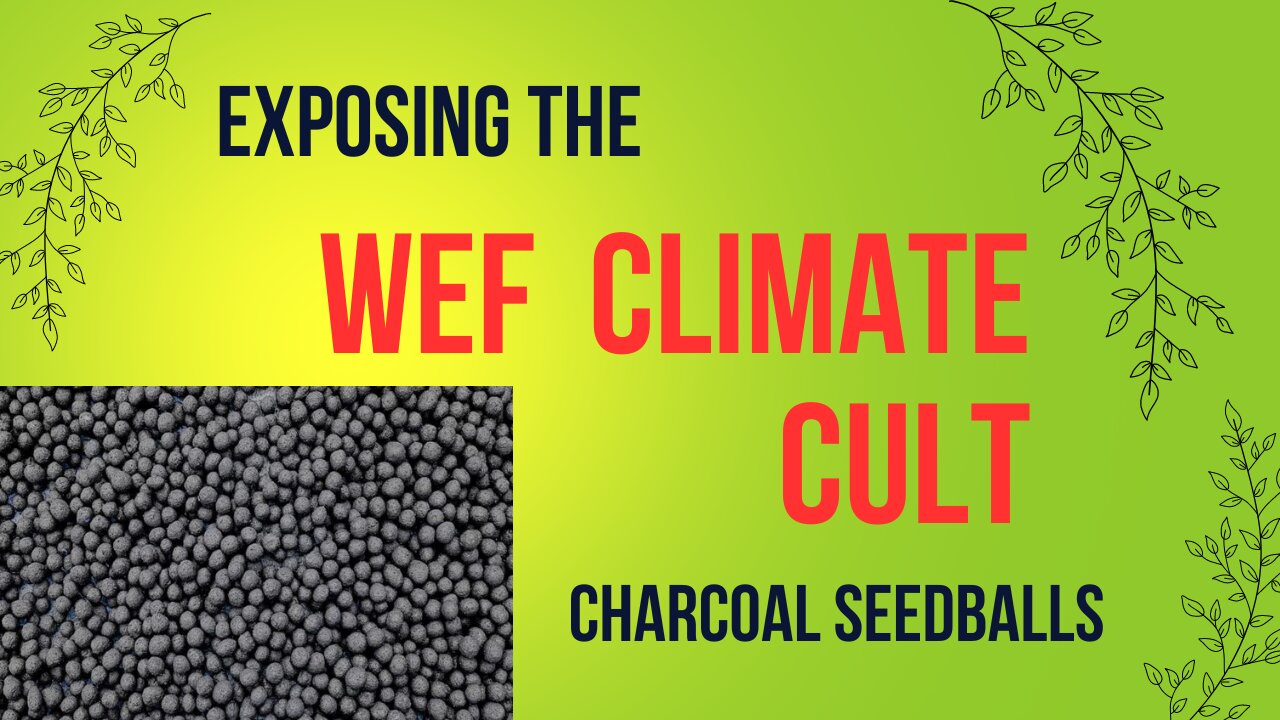Premium Only Content

Exposing the WEF Climate Cult in a nutshell (Charcoal Seedballs).
The World Economic Forum (WEF) started the one trillion tree initiative, to have at least one trillion trees growing in the planet by 2030; To capture carbon from the air. They are using any means necessary to achieve this goal. Their climate cult has an odd way of reducing carbon from the atmosphere. One of this is by recklessly tossing balls of carbon in the air in Kenya. So what are charcoal (carbon) seedballs?
The seedballs are tree seeds placed inside a small ball of charcoal dust, and this outer biochar coating (that is rich in carbon) is supposed to protect the seeds from predators until they germinate.
First, let us watch this short clip provided by the World Economic Forum three years ago.
Afribundance found that this initiative was a huge failure. We are here to call out this bluff. The charcoal seedballs were easily carried away by water during heavy rains or flash flooding. Some of the seedballs dropped in very dry areas, hardened and never cracked open at all, most seeds died from the scorching sun and hot soil.
The few young seedlings that survived and germinate, were also susceptible to destruction from various wild factors especially herbivores, high insolation, strong winds in these arid and semi-arid areas, heavy downpour etc. Here is the joke, the seedballs Kenya company has shared video of harvester ants, weavers and monkeys ignoring the charcoal seedballs. Well, guess what? Heavy rain, sunshine, strong winds buried the seeds into oblivion.
The company boasts of having ‘distributed’ 35, 480 000 seedballs since 2016. Where are the trees to show for it? Afribundance could not find a handful of these charcoal seedballs seedlings in the wild. On the contrary, we found that the Maasai and local indigenous communities were already doing an excellent job at planting the acacia trees in the ground with help from some organizations. Their trees were successfully thriving on the ground. Why mess a good thing that was already successfully working? Why not direct those funds to these indigenous communities who are great custodians of their habitats?
A great observation was raised on Research Gate by Professor Bruno Borsari. He posits that biochar production requires kilns where the temperatures need to be maintained at 400-700 degrees Celsius for several hours, generating carbon gases and a lot of thermal energy. What are they burning to keep the temperatures that high?
Professor Borsari questions, are biochar making systems truly capable of sequestering more carbon than the carbon they release in the atmosphere? He also asked can you provide evidence that biochar making contributes to a mitigation of global climate change? These are excellent questions, we shared the same sentiments exactly.
Tossing of these charcoal seedballs indiscriminately actually pollutes the air and the environment for Africa’s wildlife. It also may encourage more deforestation because the charcoal dealers feel that they are absolved of the guilt of deforestation. Additionally, encouraging children to toss these balls into the fields is irresponsible. These seedballs leave a film of charcoal dust that is harmful to the health of these kids. Afribundance encourages the traditional way of training children in responsibly planting and nurturing a tree.
Charcoal seedballs are not a viable solution since the charcoal shells from the balls remain in the ground for years adding more carbon to the soil. Question, once the carbon measurements are done, do they claim that this is the carbon that the earth has absorbed? How then can we get a clean measure of how much these carbon sinks are absorbing carbon, if we offer them a ‘carbon’ helping hand?
• Here is the kicker. Seedballs Kenya is asking you to make a real impact by helping reduce your family and business’ carbon footprint. By throwing more carbon out there!
• May be the way they are going about it would mean multiplying your carbon footprint at this point literally!
• Ironically, this ‘reforestation’ company did not join us in condemning the lifting of the logging ban by Kenya’s president William Ruto that would see the further destruction of forests in Kenya.
• We found that the only viable reason for the use of these biochar seedballs is for earning revenue from carbon credits. Carbon credits produced by biochar projects are economically competitive and part of the nature-based removal category placing them in the same group as afforestation and reforestation, soil carbon sequestration, (carboncredits.com)
• Seedballs Kenya partners include Eden Reforestation Projects that we previously exposed for spearheading reforestation projects in Kenya, while owning a carbon trading company! They use these reforestation carbon offset projects to trade for carbon credits sold to major polluters.
• How did we get here? How are we okay with this? Why are we not questioning such bogus solutions?
• Surprisingly, Africans always used clay and mud seedballs to prevent them from rodents and insects. So why mess a good organic thing? Charcoal (carbon) seedballs are destructive to the environment, harmful to wildlife and humans. This is a very ineffective way of reforesting.
• Afribundance applauds the Maasai and local communities for simply taking the time to place young seedlings in a hole in the ground, nurturing them and seeing them grow. That is true reforestation and it is making a significant difference!
-
 1:58:33
1:58:33
The Charlie Kirk Show
2 hours agoAmerica's Spiritual Revival + Runaway Judges + Vivek For Ohio | Habba, Waggoner, Vivek | 2.27.2025
79.9K5 -
 58:33
58:33
The Dan Bongino Show
5 hours agoAmerica's A-Team Hits The Ground Running (Ep. 2432) - 02/27/2025
690K929 -
 1:19:38
1:19:38
The Rubin Report
4 hours agoCNN Host Brutally Mocked for Trying to Profit Off of What He Called a ‘Conspiracy’
63.3K31 -
 2:00:42
2:00:42
Benny Johnson
20 hours ago🚨BREAKING: Epstein List, Flight Logs RELEASED Any Minute By Trump | ELITES IN PANIC
135K112 -
 2:10:17
2:10:17
Steven Crowder
5 hours agoEpstein File Watch & DOGE’s $17M Muppet Show Explained
471K317 -
 1:04:22
1:04:22
Timcast
4 hours agoTrump Orders ALL TRANS MILITARY Discharged, Trans Person CAUGHT With BOMBS At Tesla Dealership
130K122 -
 2:01:41
2:01:41
LFA TV
18 hours agoPAYBACK = JUSTICE! | LIVE FROM AMERICA 2.27.25 11AM
73.8K18 -
 DVR
DVR
Bannons War Room
9 days agoWarRoom Live
2.42M419 -
 2:17:39
2:17:39
Matt Kohrs
14 hours agoBREAKING MARKET NEWS: Bounce or Bust?! || The MK Show
84.7K1 -
 47:26
47:26
BonginoReport
7 hours agoEpstein Files Drop Today-But How Much Will They Reveal? (Ep.149) - 02/27/2025
156K170